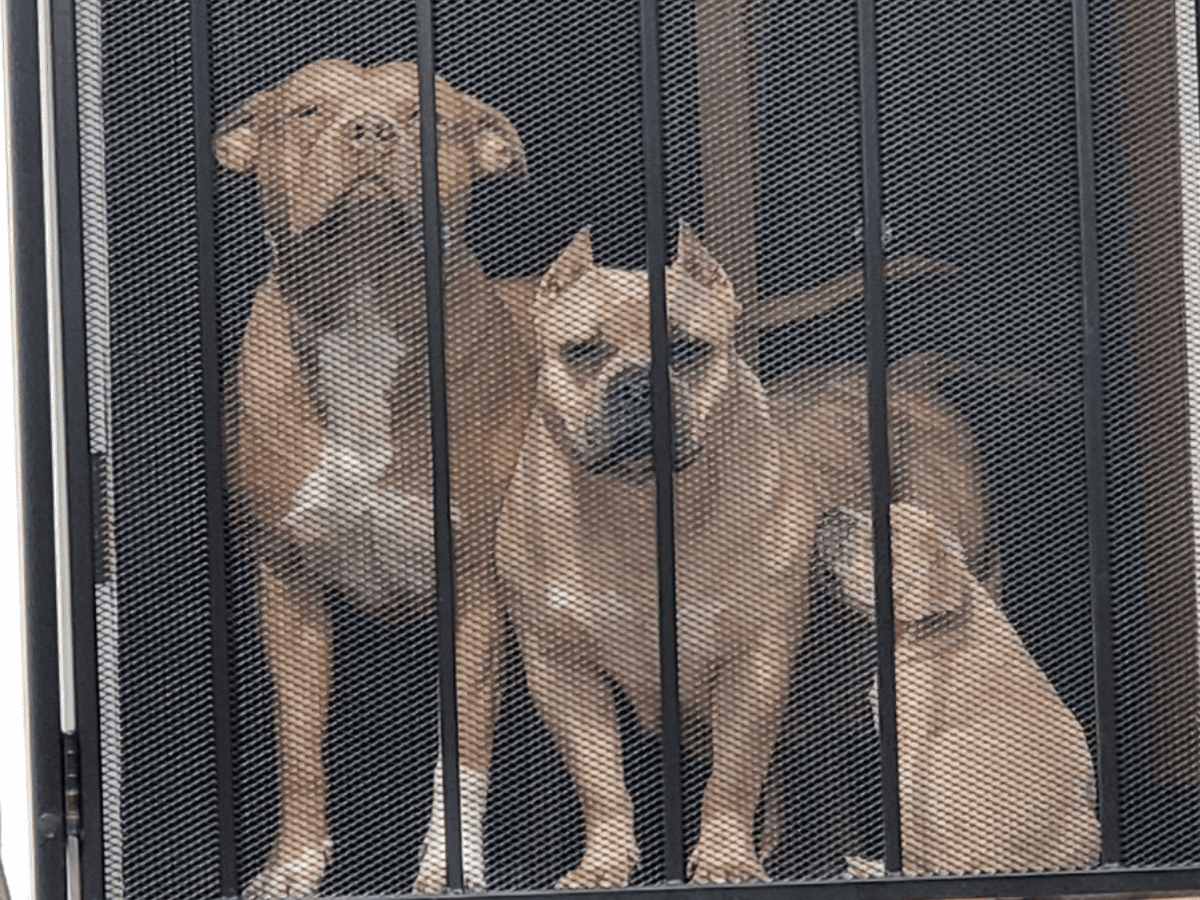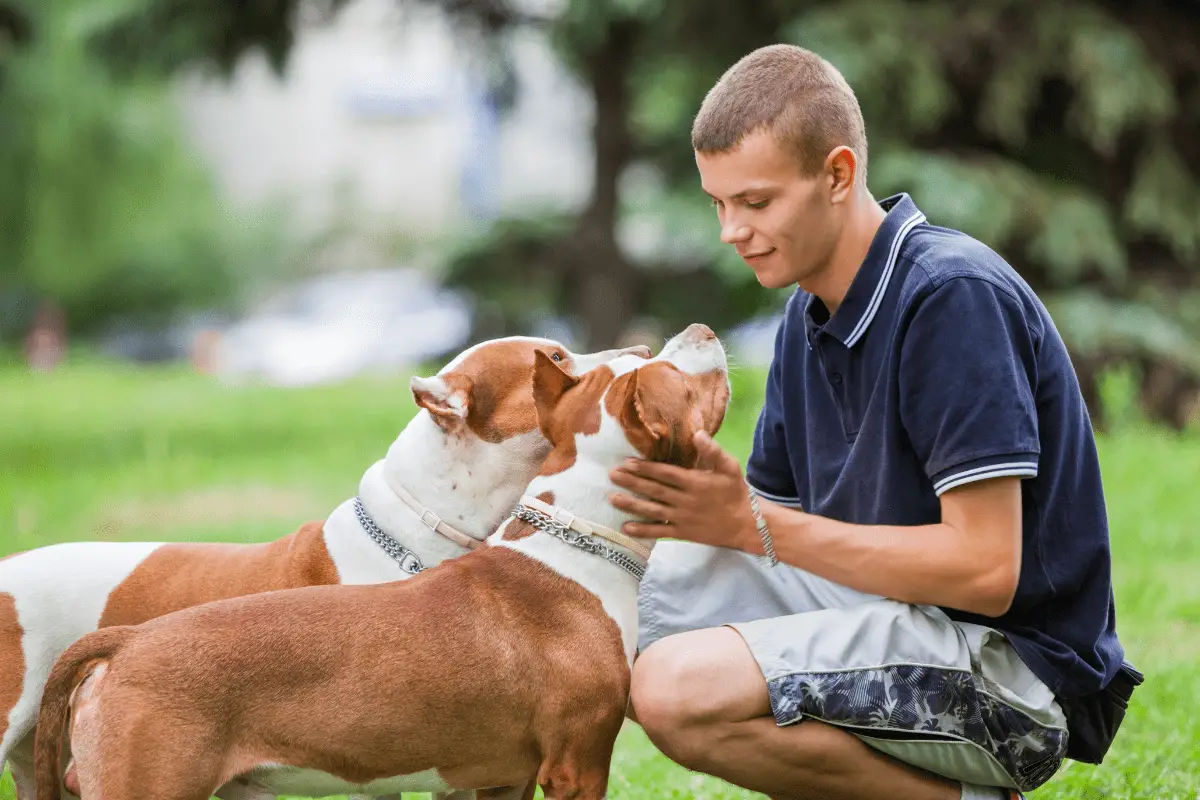Having a whole passel of canines can certainly contribute extra fun to your life, but it can also add complications.
While some breeds tend to be naturally easygoing and unlikely to seriously squabble, most of the terrier and working breeds require a little more attention and finesse from their pack leader. That would be you!
American Pit Bull Terriers combine the traits of working dogs and terriers. As adults, many would rather be the only dog in the household. So it behooves the responsible pit bull owner to pay extra attention to pack management.
Here are the most important considerations.

Two Female Pitbulls In Same House
In general, same-sex aggression is common in all dogs breeds and talking specifically about Pitbulls, two females living together in the same house can get into serious fights if not managed properly.
There are plenty of resources available to help you learn how to introduce dogs, and how to keep them from getting too excited and causing problems but you have to always keep in mind that fights can occur at any time.
If you are conscious about the risks and still decide to have one more female Pitbull in your house, make sure to introduce them properly and never leave them unsupervised, not even for a minute especially the first few months.
Pitbulls are great pets, get along well with other animals and even other dogs but that does not mean they will not get into fights.
Be prepared for the worst and hope for the best!
The most important thing you can do when managing multiple dogs in the house is to create a few boundaries early on. This will help prevent them from creating unnecessary conflict.

Get the 7 Biggest Training Mistakes free report!
Can Two Male Pitbulls Live Together
Two male Pitbulls can live together as they can with other breeds but there will always be a risk of fights between them, so you have to be conscious of it before deciding to bring a new Pitbull home.
In general, two Pitbulls from the same gender are likely to get into fights, especially if they are not introduced and managed properly, this can be unsafe for them and your family.

Pitbulls are great pets but they need a lot of attention and care. If you are not prepared to provide them both with what they need, it is better to not get another one.
Sure, if you are an experienced Pitbulls owner and are sure you can provide them with all the love, support and attention they need, you can try to bring another pittie home but please, be prepared for it.
Male And Female Pitbull Living Together
Opposite to having 2 Pitbulls from the same sex, male and female Pitbulls are more likely to have a peaceful coexistence living together.
Of course, this will depend on each individual dog’s personality but in general, they tend to get along pretty well but you have to still be careful and be an experienced Ptibull owner before considering having them living together.
If you are thinking about bringing another Pitbull to your home, having a male and female can be a great idea but as always, make sure to introduce them properly and never leave them unsupervised.
How To Make Two Pitbulls Get Along
If you already have multiple dogs, a few basic tips can work wonders for maintaining harmony.
1. Make Sure Everyone Knows You Are The Boss
Pit bulls naturally look up to humans as pack leaders, but some other breeds require convincing. And when part of the pack thinks there is instability–or, worse yet, an open slot–at the top, you are going to have difficulties.
This does NOT mean that you need to be heavy-handed or overbearing.
In fact, you should NOT be either of those things. Just make sure you exercise calm, firm, consistent leadership, with clearly defined rules, and your dogs will accept you as their leader (though some dogs are naturally mischievous and enjoy testing your rules for the sheer fun of it).
2. Create Boundaries Early

When you first bring your new dogs home, they’re likely to be pretty excited. To help prevent them from creating unnecessary conflict, create a few boundaries early on.
Keep your dogs on leashes when you first bring them home and use that time to show them where they can and cannot go. They can explore the house and yard, but they should stay leashed until you’re ready to free them.
Whenever one dog starts to sniff around a spot another dog might feel territorial about, gently tug on the leash to bring the first dog back.
Keeping your dogs on leashes for the first few days also helps you keep them separated.
A strange new dog invading another’s space can be socially uncomfortable and cause the other dog to lash out. Keep your dogs leashed until they’re well acclimated.
3. Avoid Triggering Situations
This should go without saying, but don’t bring home three super special yummy chew bones and toss them down in the middle of six dogs. That sort of thing could start a fight among heavily sedated Basset Hounds.
Obviously, everyone should get something when anyone does, and always be sure to separate your dogs before they get their chew bones. You don’t want one dog deciding he likes the other dog’s treat better, or that he likes all the other dogs’ treats.
That way lies chaos and destruction. If the dogs receive their special goodies in a separate, safe space, you can look forward to everyone peacefully enjoying their treats.
4. Feed Meals In Separate Rooms Or Crates
See above. Also, dogs that are fed in groups get in the habit of wolfing down their food as fast as possible, both so no one can steal it and–in some cases–so they can finish early and try to steal someone else’s.
It’s much healthier and far less problematic if everyone is in a safe, private area during meals, so they learn to take their time and chew properly instead of inhaling their food.
5. Be Preemptive
If you see dogs glaring at each other with ill intent or bullying one another, let them know that kind of behavior won’t be tolerated.
If the behavior persists, put them in their crate or a separate room for a time-out.
6. Make Sure You’re Disciplining The Right Dog
If your new puppy insists on using your adult pit bull’s ear as a tug toy, don’t discipline the adult dog when he growls at the puppy as a warning or snaps at her after his repeated warnings have been ignored.
Doing so would leave your adult dog feeling helpless and confused, while sending an entirely wrong set of signals to the puppy (something along the lines of “Everyone must let me do what I want or they will be punished! I rule the universe, hooray for me!”).
Prevent the situation from escalating to the growling or snapping stage in the first place by teaching your dogs that they need to respect each other’s boundaries.
7. Don’t Let The Most Aggressive Alone
Many people recommend never leaving any of the more aggressive working and terrier breeds alone together when you’re gone. Others find this advice somewhat overcautious. Honestly, it depends on the dogs in question.
You know your dogs better than anyone, but keep in mind that how they behave when you are present and how they behave when they’re alone may not be identical.
And in cases where there have been signs of aggression or fights in the past, definitely keep your dogs in different rooms or crated while you are gone.
8. Let Them Play

Last but not least, give all your dogs plenty of play, lots of exercise and at least 10-15 minutes of alone time with you every day. All of these contribute toward happier, more contented pack members.
Happy, tired dogs are less likely to fight than bored dogs.
9. Be Aware Of Individual Differences
It’s also important to be aware of individual differences within your dog family. All dogs are individuals, and, even if you keep multiple dogs together, they’ll each have their own needs.
Keep an eye on each dog’s body language, and pay attention to what they seem to need.
One dog may be more energetic than the others, and one dog may prefer more solitude than the others.
Again, these personality differences can lead to confrontation so it’s better for you to anticipate your dog’s behaviors to prevent chaos.
10. Provide Appropriate Enrichment
All dogs crave mental stimulation, but certain dog breeds crave it more than others.
Keeping multiple dogs together can be a lot of fun, but it’s important to provide enrichment so the dogs remain healthy mentally and physically.
It’s also important to provide each dog with time away from the rest of the pack.
Provide an equal balance of enrichment, play, and rest so they remain well-rounded.
Things To Consider Before Getting Another Dog
One of the best ways to maintain an orderly pack is to choose new dogs who will mix well with the current residents.
If you are considering adding another canine member to your household, be sure to take into account these things below.

Be Sure You’re Ready To Take On The Responsibilities
Before you decide to keep more than one pit bull in the house, take an honest inventory of your living situation.
Are you able to give each dog enough attention? Do you have the space for multiple dogs? Are there other animals in your home that might pose a safety risk to your pets or vice versa?
Even if you have the ability to care for multiple dogs, you should also make sure you’re ready emotionally. It’s easy to fall in love with puppies, but keeping multiple adult dogs long-term can present new challenges.
Keeping multiple dogs means giving up a bit of your freedom, scheduling time each day for walking and training, and making sure everyone gets enough attention.
It’s not a decision to make lightly, so make sure you’re prepared.
Their Gender
Most dogs find it easier to get along with the other sex. This doesn’t mean two dogs of the same sex can’t get along, or that one dog will always lead and the other will always follow.
It’s not at all uncommon among large groups for one dog to take the lead in the house, another during the hunt, another while herding, and so on.
But same sex aggression is much more likely–and much more likely to be serious–than male/female squabbles.
If you do have two males or two females, spaying and neutering will greatly reduce the risk of violence, especially among males. Males won’t fight over a female who is not in heat.
Furthermore, a neutered male is almost certain to be more easygoing. Also, do NOT assume that female dogs are more even-tempered than males.
Many experienced breeders will tell you that their most serious, intractable cases of intrapack aggression involve two females.
Age Difference
If a healthy older dog is already established in the household, younger new arrivals will usually defer to the older dog. This is true even if they are the same sex.
Dominance issues are more likely to arise when there’s not a significant difference in age.
Other age-related factors that may come into play are when a puppy hits adulthood, or when the pack leader begins to noticeably slow down during his or her later years.
Individual Temperament
Simply put, if you already have a dominant, strong-willed dog, it makes sense to choose a more easygoing canine when expanding your pack. It’s not always possible to tell what the adult temperament of a puppy is going to be (though a pushy, assertive puppy is likely to be an assertive adult), but you can look into the general temperament of the puppy’s breed (or the breed he most closely resembles in the case of mixed breed dogs).
Some breeds have a higher tendency towards dominance and dog aggression than others, and a German Shepherd is more likely to mature into a dominant adult than a Bearded Collie.
In sum, if you already own a three year old pit bull who acts assertive whenever she’s around other dogs, it’s probably not a good idea to bring home the three year old Komondor who ruled your neighbor’s acreage until that new job in downtown Manhattan opened up.
Assertive dogs do fine with other dogs as long as the other dogs are deferential. When two dogs each expect the other to defer, problems erupt.
Handling Aggression When It Arises
The first rule, once dogs begin showing real aggression toward each other, is to never, ever let them work it out among themselves. The idea that dogs who get in a fight should be allowed to keep going until they are both clear on “who’s the boss” somehow became common advice in the past, and it still rears its misguided head on occasion. It is terrible advice.
One more time–NEVER, EVER let them work it out among themselves. Allowing your dogs to settle their disputes without intervention could easily lead to severe injury or death for one or both of the dogs involved.
It will almost certainly lead to you being unable to ever again have the dogs together in the same room.
“But wait,” you say, “wild canines settle their disputes without human intervention all the time, and they usually don’t kill each other!” And this is true.
But there are two problems with the analogy. First, sometimes those disputes do end in death or serious injury. But even in the more common cases where they don’t, your home is not the wild. In the wild, the loser can leave.
Canines who can’t get along with other pack members frequently leave the pack and start their own. In your home, winner and loser are stuck together. The more serious the fight becomes, the more unpleasant the aftermath is likely to be. You really, really want to avoid this situation.
As far as breaking up fights is concerned, first, try shouting “NO!” or “STOP!” very loudly and authoritatively. Sometimes, this will stop the fight right there.
And contrary to their reputation, pit bulls are actually more likely to listen to verbal commands in this situation than most breeds. Project an image of being in control, a calm but stern figure, and don’t seem panicked or scared, even if you are.
If verbal commands fail, and there are two of you, you should each grab the back legs of a dog and pull backwards, lifting them in the air as you do so. The dogs will usually let go.
Sometimes throwing a blanket over the fighting dogs, dumping a bucket of cold water on them, or turning on the hose can also be effective.
If you are stuck breaking up a fight by yourself, and the dogs won’t heed voice commands, try to get them in a doorway and push some sort of barrier between them (baby and doggy gates work well), then close the door the moment you have them separated.
Again, contrary to their reputation, in the aftermath of a fight, pit bulls may be more likely than most breeds to listen to you and behave themselves with each other. But that is only when you are with them and no triggering situations arise.
Once two dogs have gotten into a serious fight, they will always have to be carefully supervised, and you should never leave them alone together.
If all else fail, you may have to keep the dogs entirely separate, and spend time with each of them in shifts. This is difficult but not impossible, and it is part of many people’s routine. But you’re definitely better off never letting the problem get to this point.
On the positive side, it’s much easier to avoid a serious aggression problem than to fix it. Prevention really is key here, and it’s quite possible to live in a multi-dog household–including one with multiple pit bulls–for years without ever having a serious fight break out.
Summary
Before you make the decision to keep multiple dogs in the same house, be sure you’re ready to take on the responsibilities of dog ownership.
You’ll need to block out time for training, walks, and enrichment. It also means taking extra care to manage individual differences and keeping an eye out for inappropriate interactions between dogs.
Multiple dogs can certainly be a handful, but it can also be a ton of fun!

Ihave 9 pits and they all
Ihave 9 pits and they all live int he house becouse of fights I have had to seperate them becouse of fights so now we live in shifts with some out while others are in there kennels we try not to let anyone stay in there kennel mor then 3 hours. so some do stay in rooms with my kids all of witch are over 16and have been raised with dogs all there lives. Ilove your advise and totly agree with the comment about females and fights. But sicence our oldest female was fixed she doesent get along with any of her female pups now.would you know why?